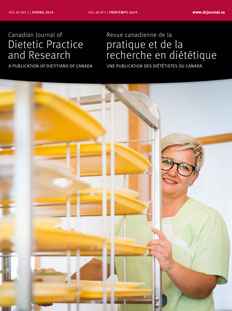Abstract
Purpose: Our study compared the prevalence of food insecurity among 3 student groups attending Memorial University of Newfoundland (MUN): International (INT), Canadian out-of-province (OOP), and Newfoundland and Labrador (NL). Factors associated with food insecurity were also investigated.
Methods: Data were collected via an online survey distributed to an estimated 10 400 returning MUN students registered at a campus in St. John’s, NL. Respondents were recruited through e-mails, posters, and social media. Ten questions from the Canadian Household Food Security Survey Module adult scale were asked to assess food security. Logistic regression was used to compare rates of food insecurity between the three population subgroups.
Results: Of the 971 eligible student respondents, 39.9% were food insecure (moderate or severe). After controlling for program type, parental status, living arrangement, and primary income source, OOP and INT students were 1.63 (95% CI = 1.11–2.40) and 3.04 (95% CI = 1.89–4.88) times more likely, respectively, to be food insecure than NL students.
Conclusions: Approximately 40% of participating MUN students experienced food insecurity, a higher proportion than reported for the overall provincial population. Groups at high risk of food insecurity include INT students, students with children, and those relying on government funding as their primary income.
Résumé
Objectif. Notre étude a comparé la prévalence de l’insécurité alimentaire dans trois groupes d’étudiants fréquentant l’Université Memorial de Terre-Neuve (UMT) : des étudiants internationaux (INT), des étudiants canadiens provenant de l’extérieur de la province (EP) et des étudiants de Terre-Neuve-et-Labrador (TNL). Les facteurs associés à l’insécurité alimentaire ont aussi été examinés.
Méthodes. Les données ont été recueillies grâce à un sondage en ligne transmis à environ 10 400 étudiants de l’UMT qui n’en étaient pas à leur première année et qui étaient inscrits à un campus de St. John’s, T.-N.-L. Les répondants ont été recrutés par l’entremise de courriels, d’affiches et des médias sociaux. Afin d’évaluer la sécurité alimentaire, dix questions provenant de l’échelle de sécurité alimentaire des adultes du Module d’enquête sur la sécurité alimentaire des ménages canadiens ont été posées. Une régression logistique a été utilisée pour comparer les taux d’insécurité alimentaire des trois sous-groupes de la population.
Résultats. Parmi les 971 répondants étudiants admissibles, 39,9 % vivaient de l’insécurité alimentaire (modérée ou grave). Après avoir tenu compte du programme, de la situation parentale, de la condition de logement et de la principale source de revenus, les étudiants des groupes EP et INT étaient 1,63 fois (IC à 95 % = 1,11–2,40) et 3,04 fois (IC à 95 % = 1,89–4,88) plus susceptibles, respectivement, de vivre de l’insécurité alimentaire que les étudiants du groupe TNL.
Conclusions. Environ 40 % des étudiants de l’UMT qui ont participé au sondage vivaient de l’insécurité alimentaire, soit une plus grande proportion que celle rapportée pour l’ensemble de la population provinciale. Les groupes à haut risque de vivre de l’insécurité alimentaire comprennent les étudiants internationaux, les étudiants ayant des enfants, et ceux dont la principale source de revenus provient du financement gouvernemental.



